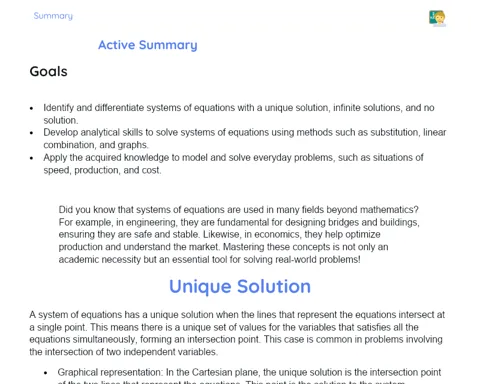Inequalities: Introduction | Traditional Summary
Contextualization
Inequalities are mathematical expressions that, unlike equations, establish a relationship of inequality between two parts. While an equation indicates that two expressions are equal, an inequality shows that one expression is greater than, less than, greater than or equal to, or less than or equal to another. This concept is fundamental for various areas of mathematics and its applications range from simple everyday problems to complex analyses in engineering and economics.
To understand better, imagine a situation where you need to ensure that the amount of money you have is sufficient to buy a certain product. If you have 20 reais and want to buy an item that costs 15 reais, you create an inequality: 20 ≥ 15. This type of reasoning is used to make informed decisions and solve practical problems, making the study of inequalities a valuable and applicable skill in various situations.
Definition and Symbols of Inequalities
Inequalities are mathematical expressions that establish a relationship of inequality between two parts, using the symbols > (greater than), < (less than), ≥ (greater than or equal to), and ≤ (less than or equal to). These symbols are fundamental to understanding the concept of inequalities, as they indicate the nature of the relationship between the two expressions.
For illustration, consider the inequality 3x - 4 > 0. Here, the symbol > indicates that the expression 3x - 4 must be greater than 0. This type of inequality is common in solving problems where it is necessary to determine an interval of values that satisfy the established condition.
Understanding these symbols allows students to quickly identify the type of inequality present in a mathematical expression, facilitating problem-solving and the graphical representation of solutions.
-
Inequalities use the symbols >, <, ≥, and ≤ to establish inequalities.
-
The symbols indicate the relationship of greater than, less than, greater than or equal to, and less than or equal to between the expressions.
-
Understanding the symbols is essential to correctly identify and solve inequalities.
Transformation of Inequalities
Like equations, inequalities can be manipulated to isolate the variable and find the solution. However, it is crucial to pay attention to the inequality sign, especially when multiplying or dividing both sides by a negative number. When this occurs, the inequality sign must be inverted.
For example, consider the inequality -2x > 6. To isolate the variable x, we must divide both sides by -2, resulting in x < -3. Note that the inequality sign was inverted from > to <. This detail is fundamental to ensure that the solution of the inequality is correct.
Manipulating inequalities requires attention to detail and understanding of basic algebraic principles. Regular practice with different types of inequalities helps strengthen these skills and gain a better understanding of how to solve problems involving inequalities.
-
When manipulating inequalities, special attention must be paid to the inequality sign.
-
Multiplying or dividing both sides of the inequality by a negative number inverts the inequality sign.
-
Practicing different types of inequalities helps develop problem-solving skills.
Solving Basic Inequalities
To solve basic first-degree inequalities, it is necessary to follow a series of steps involving isolating the variable and adjusting the inequality sign as needed. This process is similar to solving equations but requires attention to the specific details of the inequalities.
Consider the inequality 3x - 4 > 0. First, add 4 to both sides to obtain 3x > 4. Then, divide both sides by 3 to find x > 4/3. The solution indicates that any value of x greater than 4/3 satisfies the inequality.
Solving inequalities involves understanding the logic behind algebraic manipulation and applying these principles consistently. Practicing with different examples helps solidify this understanding and build confidence in solving inequalities.
-
Isolating the variable is the first step in solving inequalities.
-
Adjusting the inequality sign as needed is crucial to obtaining the correct solution.
-
Regular practice with varied examples helps solidify understanding of solving inequalities.
Representation on the Number Line
The graphical representation of the solutions of inequalities on the number line is a powerful visual tool that helps better understand the ranges of values that satisfy the inequality. On the number line, the values that satisfy the inequality are indicated by open or closed intervals, depending on the inequality symbol used.
For example, for the inequality x < 5, the solution is represented by an open interval to the left of point 5 on the number line, indicating that all values less than 5 satisfy the inequality. For the inequality x ≥ 3, the solution is represented by a closed interval to the right of point 3, including point 3 itself.
Understanding how to represent solutions of inequalities on the number line facilitates the interpretation of results and helps visualize the ranges of values that satisfy the given condition. This skill is valuable in both academic contexts and practical applications.
-
The number line is a visual tool for representing solutions of inequalities.
-
Open or closed intervals indicate the values that satisfy the inequality.
-
Graphical representation facilitates the interpretation and visualization of solutions.
Interpretation of Solutions
The interpretation of the solutions of inequalities involves understanding that the solution is a set of values that satisfy the given condition. These values can be represented in intervals, which are visualized on the number line and indicate the possible values of a variable that make the inequality true.
For example, for the inequality 2x + 5 < 15, when solved, we find the solution x < 5. This means that any value of x less than 5 satisfies the inequality. The correct interpretation of solutions helps to understand the meaning of the ranges of values and how they apply to real situations.
By practicing the interpretation of solutions, students can develop a deeper understanding of inequality concepts and apply this knowledge to solve practical problems. This skill is essential for success in mathematics and in various fields that use inequalities.
-
The solution of an inequality is a set of values that satisfy the given condition.
-
These values are represented in intervals, visualized on the number line.
-
The correct interpretation of solutions is crucial for applying knowledge to practical problems.
To Remember
-
Inequalities: Mathematical expressions that establish a relationship of inequality between two parts.
-
Inequality symbols: > (greater than), < (less than), ≥ (greater than or equal to), ≤ (less than or equal to).
-
Transformation of inequalities: Algebraic manipulation of inequalities, paying attention to the inequality sign, especially when multiplying or dividing by negative numbers.
-
Solving inequalities: The process of isolating the variable and finding the solution that satisfies the inequality.
-
Number line: A visual tool for representing solutions of inequalities, indicating open or closed intervals.
-
Interpretation of solutions: Understanding the values that satisfy the inequality and their representation in intervals.
Conclusion
In this lesson, we explored the definition and symbols of inequalities, understanding how they differ from equations by establishing relationships of inequality. We learned to solve basic first-degree inequalities by following steps to isolate the variable and adjust the inequality sign as needed. Additionally, we discussed the importance of graphically representing solutions on the number line and how to interpret these results for application in practical situations.
Understanding inequalities is essential for developing mathematical skills as well as for solving everyday problems. Inequalities are widely used in various fields, such as engineering and economics, demonstrating their practical and theoretical relevance.
We encourage students to continue exploring the topic, practicing solving different types of inequalities, and seeking practical applications to consolidate acquired knowledge. Continuous study and regular practice are fundamental to improving understanding and the ability to solve inequalities efficiently.
Study Tips
-
Review the basic concepts of inequalities and the inequality symbols. Make sure to understand the difference between equations and inequalities.
-
Practice solving different types of inequalities, including those involving multiplication or division by negative numbers, to strengthen your skills.
-
Use the number line to graphically represent the solutions of inequalities and visualize the ranges of values that satisfy the given conditions.



